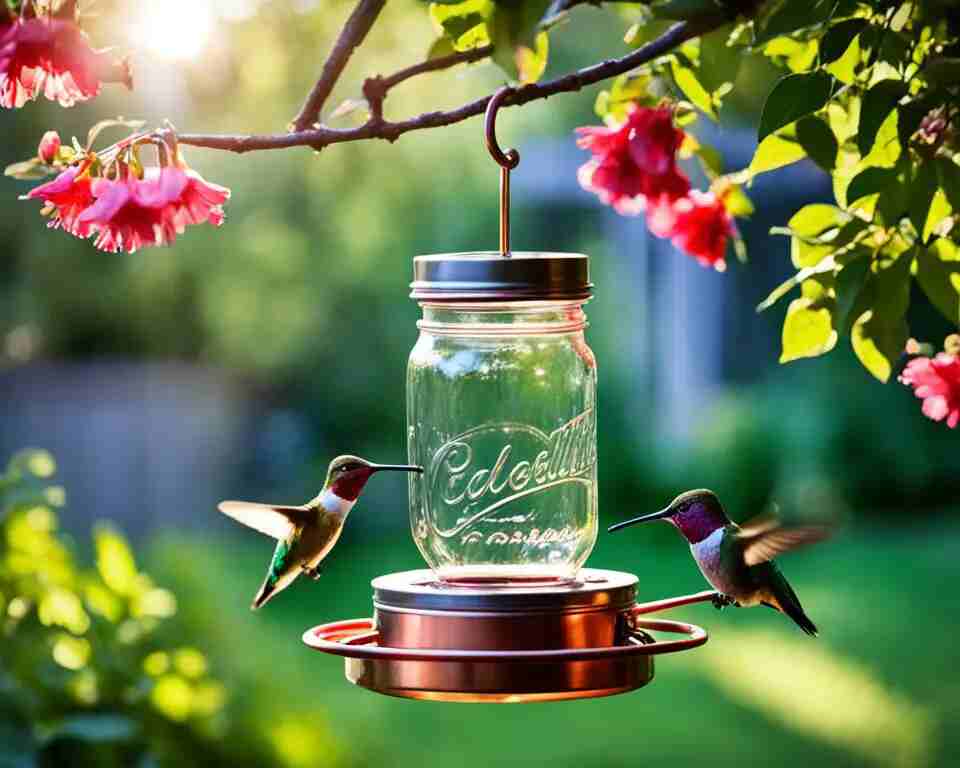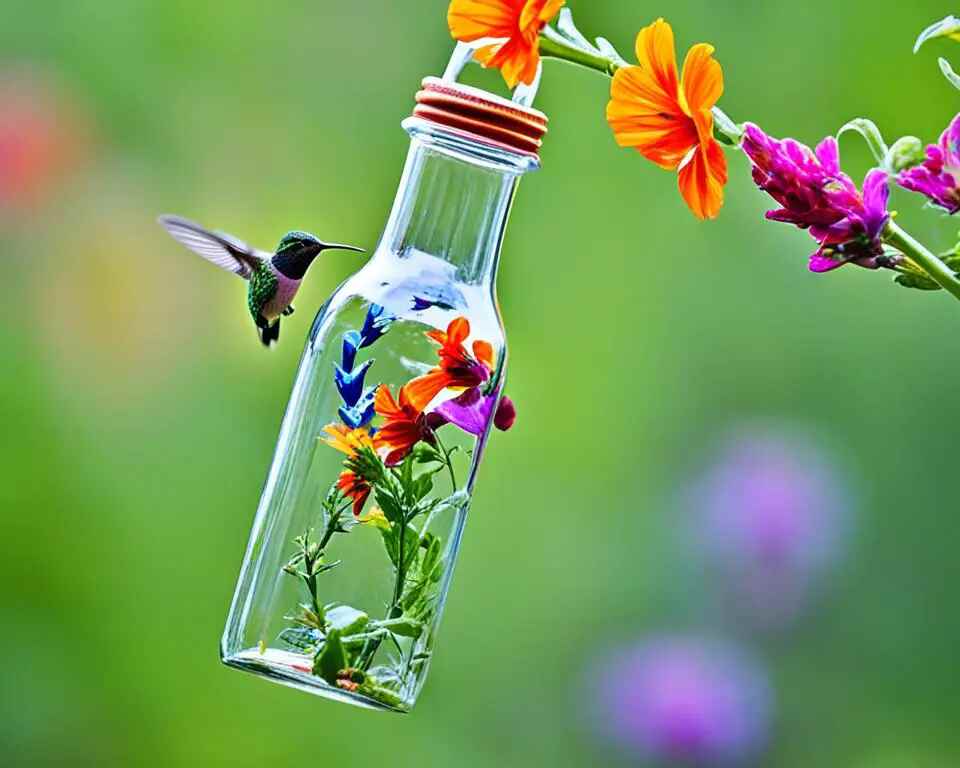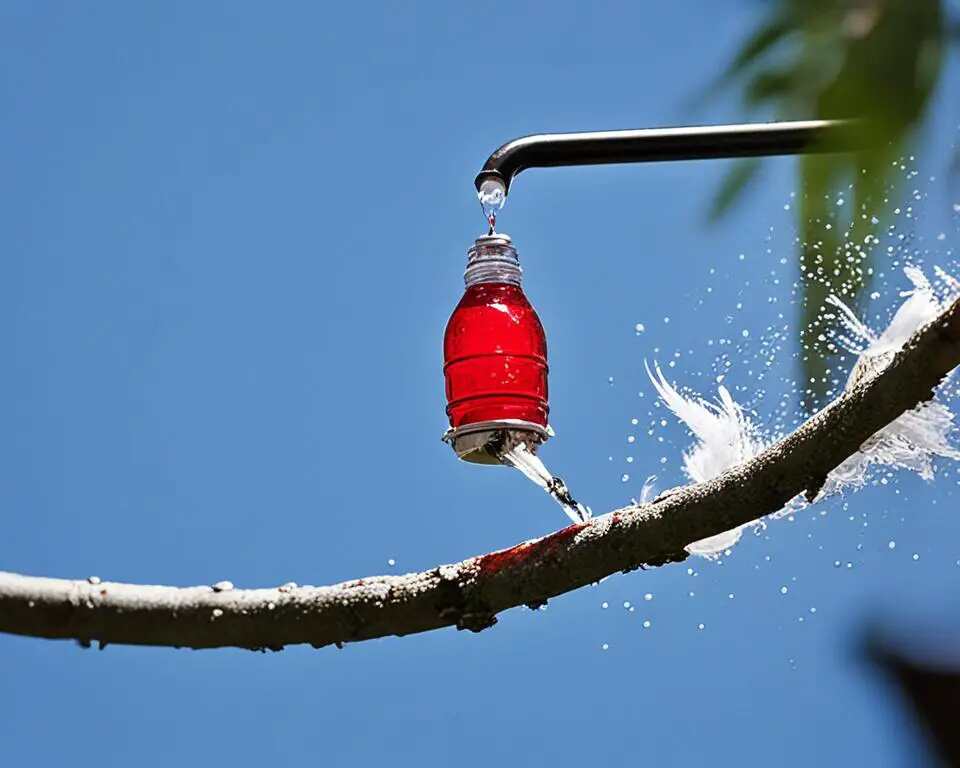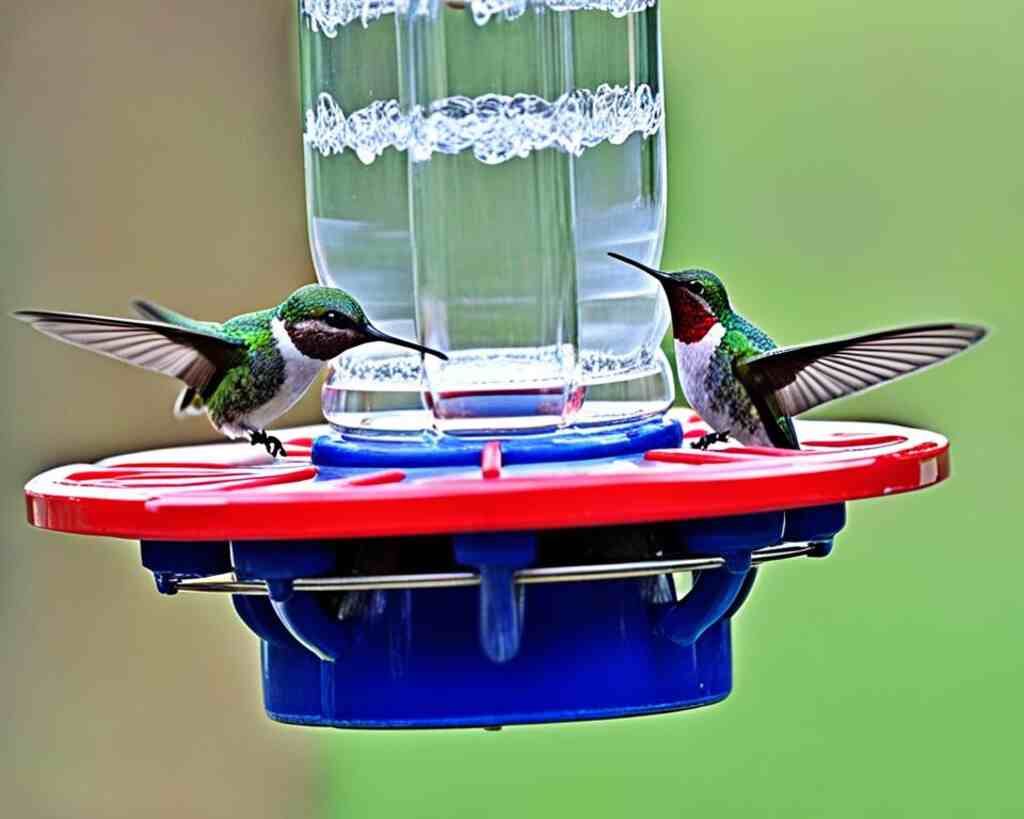Are you someone who adores nature and yearns to invite hummingbirds into your garden sanctuary? Ever thought about fashioning your very own homemade hummingbird feeder? Crafting DIY hummingbird feeders isn’t just cost-effective—it’s a delightful and imaginative endeavor.
With a plethora of inventive opportunities, from repurposing materials to dreaming up unique designs, the world is your oyster when it comes to creating a personalized hummingbird haven.
Table of Contents
- 1 Benefits of Creating Your Own Hummingbird Feeder
- 2 The Allure of Upcycled Hummingbird Feeders
- 3 Crafting the Perfect Environment for Hummingbirds
- 4 DIY Hummingbird Feeder Ideas
- 5 Innovative DIY Feeder Projects for Family Fun
- 6 Essential Tips for Hummingbird Feeder Maintenance
- 7 How to Attract Hummingbirds: Going Beyond the Feeder
- 8 Conclusion
- 9 Source Links
- 10 Author
Key Takeaways:
- Creating your own hummingbird feeder is an affordable and enjoyable project.
- DIY feeders allow you to repurpose materials and upcycle items for an eco-friendly option.
- There are various designs and materials to choose from, offering a chance to get creative and personalize your feeder.
- Attracting hummingbirds to your garden is not only beneficial for them but also creates a vibrant and lively environment.
- Proper feeder maintenance and a hummingbird-friendly habitat are essential for attracting and accommodating these beautiful birds.

Benefits of Creating Your Own Hummingbird Feeder
There are numerous benefits to embarking on an easy DIY bird feeder project and crafting a unique hummingbird feeder using recycled materials. Not only does it offer a fulfilling creative outlet, but it also provides cost savings compared to purchasing a feeder from the store.
By repurposing and upcycling materials, you can create an eco-friendly bird feeder that reduces waste and promotes sustainability. Instead of throwing away plastic bottles or jars, why not transform them into functional and attractive feeders for hummingbirds? This unique hummingbird feeder craft allows you to exercise your creativity while caring for the environment.
Creating your own hummingbird feeder also offers the opportunity to customize it to suit your garden’s aesthetic. You can choose the materials, colors, and design elements that complement your outdoor space, adding a personal touch that enhances its beauty.
With step-by-step hummingbird feeder tutorials readily available, the process becomes even more accessible for beginners. These tutorials provide clear instructions and guidance, ensuring that you can successfully complete your project and have a functional feeder ready to attract hummingbirds to your garden.
Attracting hummingbirds to your garden is not only a delightful sight but also beneficial in several ways. These small birds are effective pollinators and can help maintain the biodiversity of your garden. By providing them with an easy food source through your DIY hummingbird feeder, you support their presence and contribute to the ecological balance.
The Allure of Upcycled Hummingbird Feeders
Using upcycled materials to create hummingbird feeders is not only an eco-friendly choice but also a creative and rewarding project. Repurposing items such as plastic bottles, glass bottles, and mason jars allows you to give new life to discarded objects while providing a sustainable food source for these delightful birds.
One upcycled bird feeder idea is to transform a plastic bottle into a functional and attractive hummingbird feeder. Cut holes in the bottle to create feeding ports and attach perches for the birds to rest. Fill the bottle with homemade nectar, and you’ll have a simple yet effective feeder ready to hang in your garden.
If you prefer a more rustic and charming feeder, repurpose a glass bottle or mason jar. Drill small holes in the lid for feeding ports and insert perches made from twigs or sturdy wire. This DIY mason jar bird feeder adds a touch of elegance to your garden while providing nourishment for hummingbirds.
Another option is to repurpose a recycled bottle into a hummingbird feeder that is both functional and aesthetically pleasing. Create feeding ports by cutting small holes in the bottle, and attach perches using wire or string. Hang your recycled bottle hummingbird feeder in a location where it can be easily spotted by these vibrant creatures.
Creating an easy hummingbird feeder DIY project using recycled materials not only helps the environment but also allows you to express your creativity. Add colorful accents, ribbons, or paint to make your feeder stand out and attract even more hummingbirds to your garden. Remember to keep your upcycled feeders clean and regularly refill them with fresh nectar to ensure the health and well-being of these delightful birds.
In the table below, you’ll find a summary of the different upcycled hummingbird feeder ideas discussed:
| Feeder Type | Materials | Features |
|---|---|---|
| Plastic Bottle Feeder | Upcycled plastic bottle | Feeding ports, perches |
| Glass Bottle/Mason Jar Feeder | Upcycled glass bottle or mason jar | Feeding ports, perches |
| Recycled Bottle Feeder | Recycled bottle, wire or string | Feeding ports, perches |
Crafting the Perfect Environment for Hummingbirds
To create a hummingbird-friendly garden, it is important to consider the elements that will attract and sustain these vibrant birds. By incorporating the right plants and providing essential resources, you can create a habitat that will entice hummingbirds to visit and enjoy your garden.
One key aspect of a hummingbird-friendly garden is the selection of hummingbird-friendly plants. These are nectar-rich flowers and shrubs that hummingbirds are naturally attracted to. Brightly colored tubular flowers such as trumpet vine, bee balm, and salvia are particularly appealing to these small birds. Incorporate a variety of plants with different bloom times to ensure a continuous source of nectar throughout the season.
| Plant | Preferred Color | Preferred Shape |
|---|---|---|
| Trumpet vine | Red, orange | Tubular |
| Bee balm | Red, pink, purple | Tubular |
| Salvia | Red, purple | Tubular |
In addition to nectar-rich plants, it is important to provide food, shelter, and water sources for the hummingbirds. Planting trees and shrubs that offer perches and cover will give the birds a secure place to rest and build their nests. Installing a hummingbird feeder with a sugar-water solution provides supplemental nourishment, especially during times when nectar-producing flowers are scarce.
Creating a pesticide-free environment is crucial for the well-being of hummingbirds. Pesticides can be harmful to these delicate creatures, so opt for organic gardening practices instead. This will ensure that the hummingbirds have access to a safe and healthy habitat.
Crafting the perfect environment for hummingbirds involves careful consideration of the plants, resources, and practices that will attract and support these beautiful birds. By creating a hummingbird-friendly garden, you can enjoy the mesmerizing presence of hummingbirds in your own backyard.
DIY Hummingbird Feeder Ideas
Creating your own hummingbird feeder provides an opportunity to add flair with decorative features while ensuring accessibility and visibility to our feathered friends. By integrating natural elements in feeder design, we can create a space that attracts these delightful creatures and enhances the beauty of our gardens.
When it comes to DIY hummingbird feeder ideas, the possibilities are endless. Let’s explore some design features that will make your feeders stand out:
- Decorative Accents: Incorporate beads, charms, and colorful accents to catch the hummingbirds’ attention. These eye-catching elements not only add visual appeal to the feeders but also attract the birds to investigate and feed.
- Easily Accessible Design: Hummingbirds prefer feeders that are easy to access and feed from. Ensure that your feeder has perches or landing spots where the birds can rest while drinking nectar. This will encourage them to stay longer and return frequently.
- Visible Placement: Position the feeders in open areas where they can be easily spotted by hummingbirds. Avoid placing them near windows or obstacles that may deter the birds or pose a risk of collisions.
- Natural Materials: Incorporating natural materials like branches and leaves in feeder construction not only adds a touch of elegance but also blends harmoniously with the environment. Consider using twigs or small branches to create perches and attach containers for nectar.
By infusing creativity into your DIY hummingbird feeders, you can create a welcoming space that not only attracts these magical birds but also complements the aesthetics of your garden. Now, let’s dive into the step-by-step instructions and inspiration for different DIY feeder designs.

Innovative DIY Feeder Projects for Family Fun
If you’re looking for a creative and engaging project that the whole family can enjoy, then these DIY hummingbird feeder projects are perfect for you. Making your own feeder not only allows you to attract beautiful hummingbirds to your garden but also provides a meaningful opportunity for educational exploration and bonding.
To get started, gather some common household items and recycled materials. Let your imagination run wild as you design and personalize your feeders. Don’t be afraid to think outside the box and incorporate unique elements into your creations.
Here’s a step-by-step guide on how to make your own innovative hummingbird feeders:
- Choose your base material: You can use materials such as plastic bottles, glass jars, or even tin cans. Make sure to clean and dry them thoroughly before starting.
- Create feeding ports: Cut small holes or slits in the base material to allow hummingbirds access to the nectar.
- Add perches: Hummingbirds enjoy resting while they feed. Attach small twigs or plastic spoons near the feeding ports to provide them with a place to perch.
- Mix your homemade nectar: Combine four parts water with one part white granulated sugar. Stir until the sugar is completely dissolved.
- Fill your feeder: Pour the nectar into the base material, making sure not to overfill it.
- Hang your feeder: Find a suitable location in your garden where the feeder can be easily seen and accessed by the hummingbirds.
Once your feeders are ready, sit back and enjoy the beautiful sight of hummingbirds frequenting your garden. Remember to clean and refill your feeders regularly to keep them fresh and enticing for the birds.
These DIY feeder projects not only add aesthetic value to your garden but also provide a unique opportunity for families to come together, learn, and appreciate the wonders of nature. So, gather your loved ones, unleash your creativity, and embark on a delightful journey of DIY hummingbird feeders.
Essential Tips for Hummingbird Feeder Maintenance
Proper maintenance is key to keeping your hummingbird feeders clean and ensuring the health of these beautiful birds. Regular cleaning and hygiene practices will prevent the growth of harmful fungi and provide a safe feeding environment. Additionally, regular refreshment of the nectar is essential to prevent spoilage. Let’s explore some essential tips for maintaining your hummingbird feeders and adjusting their diet according to the seasons.
First and foremost, it is crucial to clean your hummingbird feeders regularly. A dirty feeder can lead to the growth of mold and harmful bacteria, which can be detrimental to hummingbirds’ health. Aim to clean your feeders at least once a week, more frequently in hot and humid climates.
To clean your feeder effectively, disassemble it and wash all parts thoroughly with warm water and mild dish soap. Use a bottle brush or a small brush with soft bristles to clean the nooks and crevices. Rinse well and allow all parts to dry completely before reassembly.

When it comes to cleaning agents, avoid using bleach or harsh chemicals as they can be harmful to hummingbirds. Stick to mild dish soap or specialized bird feeder cleansers available in pet stores or online.
In addition to regular cleaning, it is essential to refresh the nectar in your feeders regularly. Nectar that is left out for too long can ferment and become toxic to hummingbirds. Aim to change the nectar every 3 to 5 days, depending on the weather conditions. In hot climates, it may be necessary to change it even more frequently to prevent spoilage.
When preparing nectar, avoid using artificial sweeteners, honey, or food coloring. A simple homemade nectar recipe consists of a mixture of four parts water to one part white granulated sugar. Boil the water, dissolve the sugar completely, and let the mixture cool before filling your feeders.
Lastly, it is crucial to make seasonal adjustments to the hummingbird diet. During the breeding season in spring and summer, hummingbirds require additional protein sources to support their energy needs. You can offer small insects like fruit flies or sugar water infused with a protein supplement, available in stores that specialize in bird supplies.
In the winter months, when hummingbirds migrate to warmer regions, they may not be present in some areas. In these cases, it is essential to clean and store your feeders properly to prevent the growth of mold or bacteria. Store the feeder in a cool, dry place until the hummingbirds return in the spring.
By following these essential tips for maintenance, cleaning, and seasonal adjustments, you can create a healthy feeding environment for hummingbirds and enjoy their presence in your garden year-round.
How to Attract Hummingbirds: Going Beyond the Feeder
While hummingbird feeders are a fantastic way to attract these delightful birds to your yard, there are additional strategies you can implement to create an inviting habitat that will keep them coming back. By incorporating these tips and ideas, you can enhance your backyard birdwatching experience and provide a haven for these tiny creatures.
Create a Hummingbird-Friendly Yard
To attract hummingbirds, it’s important to cultivate a yard that offers a variety of nectar-rich flowers. Plant a diverse selection of bright-colored blooms such as salvia, bee balm, and trumpet vine. These vibrant blossoms act as beacons, drawing hummingbirds to your garden.
In addition to flowers, consider adding hummingbird-friendly shrubs and trees to your landscape. Species like red buckeye, fuschia, and butterfly bush not only provide nectar but also offer shelter and nesting spots for hummingbirds.
Remember to provide a reliable water source as well. Hummingbirds enjoy bathing and drinking from shallow birdbaths or misters. By including a water feature in your yard, you can create an oasis for these delightful birds.
Offer a Diverse Food Supply
While nectar is the primary source of food for hummingbirds, they also supplement their diet with insects and spiders. By ensuring a diverse food supply, you can attract more hummingbirds to your yard.
A homemade nectar recipe is a great start, but consider supplementing their diet with other natural foods. Planting insect-attracting flowers and avoiding harsh pesticides can help create a healthy ecosystem that supports the hummingbirds’ needs.
Other Supplemental Food Sources
| Supplemental Food Sources | Description |
|---|---|
| Fruit Trees | Planting fruit trees such as apple, cherry, or peach can attract insects and spiders that hummingbirds feed on. |
| Native Plants | Incorporating native plants into your landscape provides a natural and abundant source of insects for hummingbirds to feed on. |
| Insect Feeders | Offering live or dried mealworms in special feeders can attract hummingbirds and provide a protein-rich food source. |
By combining these strategies with your hummingbird feeders, you can create an enticing environment that attracts and sustains these fascinating birds. Observing hummingbirds in your yard will not only bring joy to your backyard birdwatching experience but also contribute to their overall conservation and well-being.
Conclusion
In conclusion, DIY hummingbird feeders offer a world of inspiration for bird enthusiasts and gardeners alike. By embarking on your own homemade feeder projects, you not only save money but also unleash your creativity and enjoy a sense of accomplishment. The possibilities for unique and eye-catching designs are endless, allowing you to tailor your feeders to match your personal style and garden aesthetic.
Remember, attracting hummingbirds goes beyond just providing them with feeders. Creating a welcoming habitat is key to enticing these beautiful creatures. Incorporate a variety of nectar-rich flowers and plants in your garden to provide abundant food sources. Don’t forget to include water features and consider planting native species that hummingbirds prefer.
To ensure the health and happiness of the hummingbirds, regular maintenance of your feeders is essential. Clean them regularly using a mild soap solution and scrub brushes, and change the nectar every few days to prevent spoilage. Additionally, make adjustments to the nectar recipe based on the birds’ seasonal dietary needs.
So, why wait? Let the DIY bird feeder inspiration take flight in your garden. Whether you follow homemade hummingbird feeder plans or create your own, the joy of observing these tiny, vibrant creatures in your backyard is worth the effort. Have fun exploring easy DIY bird feeder projects and designing unique bird feeder designs that will surely attract the attention of hummingbirds!



